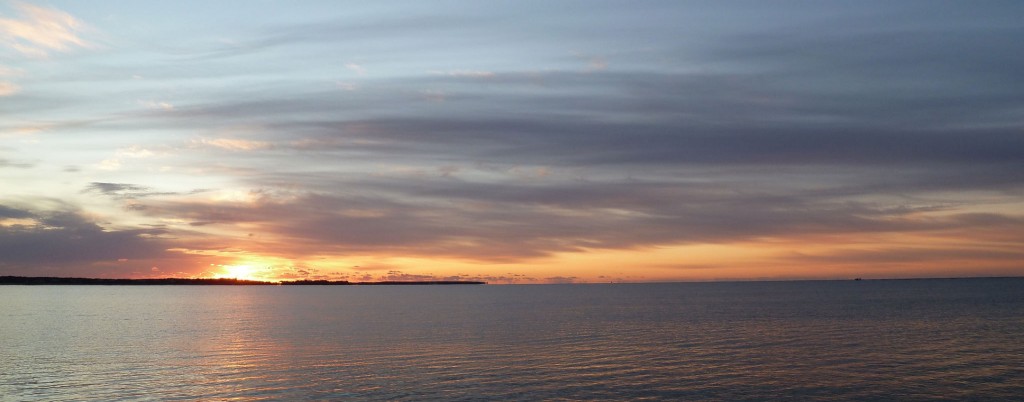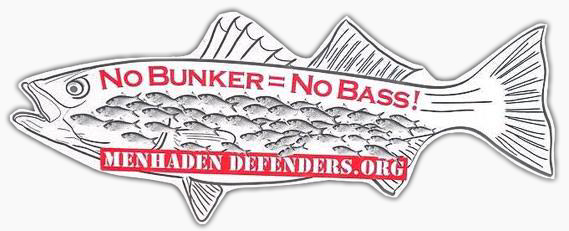Mid-Atlantic Council Approves Ecosystem Approach to Fisheries Management (EAFM)
AUGUST 10, 2016
VIRGINIA BEACH, VA – Today the Mid-Atlantic Fishery Management Council unanimously approved a guidance document to facilitate the transition to an ecosystem approach to fisheries management (EAFM) in the Mid-Atlantic. The EAFM Guidance Document is designed to serve as an umbrella document that will enable the Council to coordinate ecosystem considerations across fishery management plans (FMPs).
The Council has been considering mechanisms to introduce ecosystem considerations into the fishery management process since the late-1990s. After a review of the various approaches used around the U.S., and extensive input from fisheries stakeholders through its visioning project, the Council decided in 2011 to pursue a transitional approach which would introduce ecosystem considerations into fishery management actions in a step-wise, evolutionary fashion. This approach is intended to allow the Council to meet its current requirements for the management of individual stocks while moving towards an approach that takes into account interactions at multiple dimensions of the environment and ecosystem.
“The EAFM Guidance Document responds to broad public interest in incorporating ecosystem considerations in the management of marine fisheries and will be a critical tool for the Council as it transitions from single-species management to a more comprehensive, ecosystem-based approach,” said Council Chairman Rick Robins. “One of the most important aspects of this approach is that it will allow for the evolution of our EAFM policy at a rate commensurate with the availability of the science to support it.”
The Council’s EAFM approach is organized around four major ecosystem-related issues: forage species, habitat, climate change and variability, and interactions. Development of the document was informed by a series of four workshops which brought together scientists, managers and stakeholders to discuss each issue and associated best management practices.
The EAFM Guidance Document and supporting documents are available at: www.mafmc.org/eafm
Article source link: http://www.mafmc.org/newsfeed/2016/mid-atlantic-council-approves-ecosystem-approach-to-fisheries-management-eafm-guidance-document
This has a real, even likely possibility, to become the norm in all NOAA regulated fisheries. The key point here is, “The EAFM Guidance Document is designed to serve as an umbrella document that will enable the Council to coordinate ecosystem considerations across fishery management plans (FMPs).
Many folks including most within the Stripers Forever conservation community have been advocating for EAFM to become the standard operating model for the management of our coastal resources. It is the details within the Document that will define the goals and the implementation of management protocol. Until the details can be scrutinized we can’t be certain to what degree the “value” of a species will include or be defined by its recreationally generated economy. We shall wait and see but this policy shift has terrific potential to finally place a real value on wild striped bass and have them managed accordingly……. as a game fish!
-Dean Clark, MA Co-Chair/ National Board Member
Important News Update- ASMFC To Vote On Menhaden Management

© Dean Clark
This newsletter will focus on one development that could be (hopefully) the litmus test for all future marine species management decisions: ecosystem based fisheries management. While most of us are preoccupied doing “field research” on striped bass and chasing golf balls during our leisure time, our dedicated volunteer Ken Hastings attends nearly every Atlantic States Marine Fisheries Commission (ASMFC) meeting as a spokesperson for Stripers Forever. Thank you Ken, you are doing a terrific job and a real service toward our conservation efforts.
Ken reports that during an intense and indecisive debate (8/3/16) on whether or not to increase the menhaden harvest, the ASMFC voted to delay their final decision until their next meeting by which time a scientific assessment of the importance of menhaden to the entire ecosystem will be available. The ASMFC will be shifting menhaden management to ecosystem based management in 2018. Ken reports that conservation was a realistic, not a forgotten concern during the animated discussion!
The conservation argument against increasing the harvest was defiantly put forth by Loren Lustig from PA. Loren is a life-long fisherman and also an environmental educator. Ken explained that “Loren opposed the (harvesting) increase out of concern for how he could explain to his students why we should be gambling with the environment they will inherit from us. WOW doesn’t come close to describing his eloquent defense of the environment we all share.”
We all owe Loren, Ken and those members of the ASMFC who had the courage to stand up to the commercial interests led by the mega-million dollar reduction fishery voice and influence of Omega Protein. Part of the good news is that some members of the ASMFC are showing some backbone and willingness to do what everyone knows is the “right thing” as the appointed stewards of our marine resource and we applaud them for their courage and their wisdom.
What follows is an excerpted argument against increasing the menhaden harvest put forth by the Conservation Law Foundation. It succinctly states why menhaden are so important and is interesting reading. A large and healthy menhaden stock is a prerequisite food source for a healthy wild striped bass population. We must all be concerned and involved in bringing it back to its once abundant status if we ever want to have a healthy striped bass population.
Enjoy your summer and please let the big ones go and become members of our Release a Breeder Club.
Thanks-
Dean Clark, National Board Member/ MA Co-Chair
Menhaden Defenders is a great group of conservation minded anglers and concerned citizens who want to restore Atlantic Menhaden to sustainable levels. For more news updates concerning Menhaden please visit their website and become a member.
Excerpts from a recent Conservation Law Foundation paper stating the arguments against increasing the menhaden harvest.
If managers increase the catch limit, hundreds of millions more menhaden—often called “the most important fish in the sea” because of their role as food for predators—will be removed from the Atlantic Ocean. Here are 10 reasons the (ASMFC) board should not raise the existing catch limit on these forage fish:
1. Don’t mess with success. The ASMFC created the first coast-wide catch limit in 2013 and set the allowable catch lower than the amount taken in preceding years in order to help menhaden rebuild. The quotas leave hundreds of millions more menhaden in the Atlantic to become food for fish, seabirds, and mammals. Early reports suggest that conservation is working and the menhaden population is growing.
2. Predators need menhaden in the water. Last year, the ASMFC committed to shift from single-species management of menhaden to a big-picture approach recognizing that menhaden serve a critical role in the water as food for important predators. Managers should not change the catch limit until scientists and managers complete their work examining how menhaden numbers affect predators.
3. Especially predators recovering from low population numbers. Striped bass and weakfish eat menhaden, and their populations are struggling. Other important species such as humpback whales, eagles, and osprey depend on menhaden for food as they recover from decades of challenges. Taking millions more menhaden from the ocean could harm efforts to rebuild these species by reducing the availability of prey.
4. There is no new science to justify an increase. A decline in forage fish can cause negative impacts that ripple through the ecosystem, so coast-wide catch limits should always be based on the best available science. Managers increased the menhaden quota by 10 percent in 2015 based on the most recent available assessment, but there is no new assessment to turn to this year. Therefore, managers should wait until scientists complete their new plan, including an evidence-based analysis of the health of the Atlantic population and the effect of any change in catch limits on the ecosystem.
5. Menhaden have not recovered their historic range off the Northern and Southern states. There is some evidence of recovery in the Mid-Atlantic and Southern New England, but menhaden remain far below their historic numbers in the Northern and Southern regions of the East Coast. However, if conservation efforts continue, they can be abundant again from Maine to Florida.
6. The Chesapeake Bay is vulnerable. The vast majority of the menhaden fished coast-wide are caught in one relatively small area near the mouth of the Chesapeake Bay, which is also a vital nursery area for many ocean species. An increase in the 2017 quota would intensify fishing in this important and vulnerable estuary, which is already harmed by the loss of important habitats and poor water quality.
7. There are warning signs in the science. The latest peer-reviewed scientific assessment identified a growing number of mature menhaden, indicating that the population is poised to increase. But it also suggests that menhaden are still vulnerable: The overall number in recent years was near historic lows, as was the number of young fish surviving long enough to reproduce and help the population grow.
8. The public supports leaving more menhaden in the water. Atlantic menhaden are a public resource. Over the past decade, comments from stakeholders in every East Coast state have overwhelmingly supported leaving more menhaden in the water as prey for predators. A record 147,700 people wrote in and more than 300 attended a meeting to support conservation management when the ASMFC set the first catch limit.
9. Stability is good. Managers are awaiting a scientific assessment in 2017 and will shift to new ways of managing (ecosystem ed.) fish in 2018. Increasing the catch limit now could be followed by a reversal—an unfortunate “regulatory whiplash” that presents a challenge to businesses. Staying the course with the current catch limit will give businesses the confidence to plan ahead and make sustainable investments. Reducing pressure on forage fish also helps build resilience for wildlife in our changing oceans.
10. Conservation is a smart investment. Giving menhaden time under current catch limits to return to their historic population size and range will deliver the highest benefit to Atlantic coast ecosystems, economies, and fishermen.
Sold Out Cheeky Catch And Release Tournament Huge Success
Dean Clark, Cape Cod, Massachusetts:

Two hundred and forty dedicated fishermen descended on Cape Cod to take part in a 100% catch and release striped bass fishing tournament organized by Cheeky Reels. The Cheeky Schoolie Tournament as it bills itself took place the weekend of May 20th and is a wade and fly fishing only competition. There is no fishing from boats and only fly fishing is permitted. Two person teams combine their catch of their four largest fish and vie for thousands of dollars’ worth of sponsored prizes: Thomas and Thomas rod, Yeti coolers, Simms waders and Fish Pond tackle organizers are but a few of the winnings.
The night before the one day fishing event everyone gathered at the Swan River restaurant in Dennis for the “Captains” meeting which was hosted by Costa Sunglasses. Ted Upton of Cheeky Reels welcomed everyone and briefly went over the rules explaining that this is a fun tournament with various winning categories. In addition to vying for the largest fish there were prizes for the team that caught no fish, a winning category for the team that recorded the smallest fish and another for the team that covered the most miles in pursuit of the schoolie stripers that have invaded the Cape waters.
The next day started early with the distribution of contest kits which included an ID disk to be present in the photos of entered fish along with a ruler which also had to be in the photo of the fish. Included in each anglers kit was a Stripers Forever Tee-shirt which was graciously donated by Black Eel Outfitters of Dennis, MA.
At the Awards event Ted thanked all the generous sponsors and informed everyone that Cheeky is proud to sponsor the Stripers Forever Release a Breeder Club. In the name of conservation he reminded everyone to let the bigger bass go so they may continue to reproduce as the life-blood of the species. Stripers Forever wishes to thank both Cheeky Reels and Black Eel Outfitters for their generous and continuing support of our efforts to conserve wild striped.
The Economic Value & Impact Of The MA Recreational Wild Striped Bass Fishery
The attached analysis, based on published data from l\IOAA, shows that the recreational fishery for wild striped bass (WSB) is one of the most economically valuable in the state, rivaling the MA scallop fishery in its economic impact on the economy of the Commonwealth of MA.
- In its annual direct spending effects, the MA recreational WSB fishery is on average worth 130 times the dollar value of annual commercial WSB fishery landings in MA.
- In its annual direct spending effects, the MA recreational WSB fishery totals, on average over the most recent ten years from 2006 to 2015, fully 77 percent (ranging from 70% to 120%) of the worth of commercial landings for the entire MA seafood industry.
- In its full economic impact, the MA recreational WSB fishery amounts to an annual average of 36 percent (ranging from 27 to 44 percent) of the full economic impact of the entire MA seafood industry during the 10 year period from 2006 to 201
The analysis shows that the MA recreational WSB fishery, rather than being just a playground for the idle rich (as it is too often portrayed), is one of the most important marine fisheries in the Commonwealth of Massachusetts in its spending and economic impact on the MA state economy. Even in its current state of depletion, this fishery rivals the MA scallop fishery in its economic contributions. Were the MA recreational WSB fishery managed for recreational abundance as a game species, rather than being commercially overexploited for a minimum value, the economic significance of this fishery would increase in impact by as much as – if not more than – $1.7 billion per year on the MA economy (based on applying angling expenditures per trip in 2015 to the peak year’s number of angling trips in 2007).
The results suggest that the MA recreational WSB fishery ought to be managed for its maximum economic contribution and value as an exclusively recreational fishery by declaring striped bass a game species in Massachusetts coastal waters. This strategic shift would allow this important fishery to be managed for conservation and abundance, assuring us of a healthy recreational sport fishery in MA for many years to come. Massachusetts could once again become known as “the place to go” for great saltwater fishing as a worldwide tourist angling destination.
Contact: Frederic B. Jennings Jr., Ph.D.
Center for Ecological Economic and Ethical Education (CEEEE) Post Office Box 946, Ipswich, Massachusetts 01938-0946 Email: ecologicaleconomics@yahoo.com
Phone (messages only): 1-978-356-2188
PRESS RELEASE: ………………………………19 April 2016, for immediate release.
Contact: Frederic B. Jennings Jr., Ph.D.
Center for Ecological Economic and Ethical Education
P.O. Box 946, Ipswich, MA 01938-0946 Email: ecologicaleconomics@yahoo.com
NOAA DATA SHOW THE RECREATIONAL FISHERY FOR WILD STRIPED BASS IS ONE OF THE MOST ECONOMICALLY IMPORTANT MASSACHUSETTS FISHERIES
Revelations: Recent analyses of NOAA data reveal surprising insights into the relative worth of the MA recreational and commercial wild striped bass (WSB) fisheries. Based on information provided by NOAA, the MA recreationally-allocated portion of the WSB fishery is, on average, 130 times more economically valuable than the commercial component of this fishery. NOAA data also show that sport fishing for WSB in MA is the Commonwealth’s most economically important marine recreational fishery.
When compared to other MA commercial fisheries, NOAA data show that the value of the commercial portion of the MA WSB fishery on average represents only 0.37 percent (1/270th) of the value of all MA combined commercial landings. This ranks WSB as one of the least commercially valuable fish in the Commonwealth. NOAA numbers clearly show that the far greater economic value of WSB is realized in their recreational use and not as a massively-undervalued commercial commodity.
This analysis, based entirely on NOAA data, shows the recreational WSB fishery to be so economically important to the Commonwealth that it vies with the most valuable commercial fishery on the entire east coast: the MA scallop industry. Surprisingly, the NOAA data reveal that the MA recreational WSB fishery is on a par with the MA commercial scallop fishery as the two most economically valuable fisheries in the Commonwealth!
Consequences: NOAA data unquestionably show that the current management policy of dividing WSB allocations between recreational and commercial use is costing the MA state economy over $1 billion per vear in unrealized economic gains with an associated loss in jobs and state tax revenues. The data also show that in order to realize the greatest return from this fishery, it needs to be managed for recreational abundance, and not commercially exploited for a much smaller commercial value.
CHOICES: NOAA’s data clearly define the relative economic importance of the currently divided MA WSB fishery. The question now ought to focus on what those responsible for its management will do once the full economic value of this fishery is recognized.
Potential: NOAA figures clearly show that if striped bass stocks were protected from commercial exploitation and managed exclusively for abundance as a recreational resource, the dollar value of the MA WSB fishery has the potential to more than double or triple, with an added potential economic impact of $1.5 billion per year for the economy of the Commonwealth.
Summary: This analysis of NOAA’s figures suggests that MA would be wise to re-think our fisheries management policies with regard to this unique and valuable resource.
Explanation of FBJ Analysis of Economic Losses from Declining Striped Bass Trips in MA
Frederic B. Jennings Jr., Ph.D. – 19 April 2016
The attached analysis reveals the economic importance of the MA recreational wild striped bass (WSB) fishery. The spreadsheet has three tables showing that the direct annual spending effects of the MA recreational WSB fishery range from 70 to 120 percent (with a 10-year average of 77 percent ) of the value of annual commercial landings for the entire MA seafood industry! When the full economic effects of these two sectors are compared, the annual impact of the MA recreational WSB fishery averages over 35 percent ofthe whole MA commercial fishing industry, with a range of 27.4 to
- percent over the last 10 These results show that the MA recreational WSB fishery is by far one of the most important marine fisheries in this state, perhaps rivaled only by the MA scallop fishery in its full economic impact.
Table One shows the annual recreational catch of WSB in MA from 2006 to 2015 (with the percentage loss therein relative to the peak catch in 2006). The next three lines show the same annual data for recreational WSB fishing trips in MA (compared to the peak in 2007). Then angler expenditures per trip are shown for each year, based on NOAA data from 2006 to 2012 (extrapolated for subsequent years using regional Consumer Price Index [CPI] data). The number of WSB trips are then applied to expenditures per trip to derive total angler expenditures per year on WSB fishing trips and related equipment for 2006 to 2015. The next line shows similar data for the total economic impact of recreational WSB angling in MA, while the final two lines in Table One show the economic value and impact per fish caught in each year. Finally, the last three columns in the lower half of Table One compare the actual 2015 annual WSB recreational spending and impact (per year and per fish) to what it would be with the number of WSB angling trips seen in 2007 and in 2014.
Table Two then summarizes this last comparison between 2015 actual data with what it would have been with the number of WSB angling trips in 2007 and 2014 to show implied losses in direct expenditures attributable to declining recreational WSB catches and trips of over $550 million in the 8 years since 2007, and of over $230 million in just one single year alone. The annual losses in full economic impact during those two periods are much larger: respectively, these annual losses are $1.7 billion and $700 million. In sum, had the MA WSB fishery been managed to maintain its abundance at 2007 or 2014 levels, its 2015 spending and economic impact would have been higher by 149% or 62%. These economic losses translate directly into significant annual job and taxable revenue losses for the state’s economy.
Table Three compares the size and economic importance of the MA commercial and recreational WSB fisheries thus:
- In poundage, the commercial WSB fishery averages less than 37% or 1/270th of total MA commercial landings.
- In dollar value, the commercial WSB fishery on average lands 66% or 1/150th of total MA commercial landings.
- Direct recreational WSB spending averages annually over 130 times the value of MA commercial WSB
- In its annual spending effects, the recreational WSB fishery is generally worth 77% of all MA commercial
- In its economic impact, the recreational WSB fishery is on average worth 36% of the entire MA seafood
BOTTOM LINE: The spending effects and full economic impact of the MA recreational WSBfishery – with respect to its role in the state’s economy (and thus on jobs and tax revenues) – makes it one of the most important MA fisheries. With a healthy WSB fishery – managed for conservation and abundance – the economic impact of the MA recreational WSB fishery would double or triple, becoming worth far more than the current value ofthe entire MA seafood industry.
The relative economic value and impact of the MA commercial WSB fishery is quite trivial when compared with the value of the MA recreational WSB fishery, with a negligible economic contribution to our state’s economy. Making WSB a gamefish, and ending the wasteful commercial harvest of this valuable sport fish, should have a major positive impact on the MA state economy by allowing the WSB fishery to recover from its currently depleted state, with a potential economic impact of $1.7 billion per year (as shown in Table Two). We need to rethink our approach to the management of this extremely valuable fishery in the Commonwealth of Massachusetts.
Respectfully submitted,
TABLE ONE: REVENUE IMPACT OF DECLINING WILD STRIPED BASS RECREATIONAL FISHING TRIPS COMPARED TO THE COMMERCIAL FISHERY IN MA FROM 2006 TO 2015
| Year | 2006 | 2007 | 2008 |
2009 |
2010 |
2011 |
|
| Recreational Catch of WSB in MA, 2000-201S | 8,124,766 | 5,646,880 | 4,027,374 | 2,627,003 | 2,012,483 | 1,228,699 | |
| % of WSB Caught relative to Peak Year in 2006 | 100.0% | 69.5% | 49.6% | 32.3% | 24.8% | 15.1% | |
| % of WSB Catch Shortfall relative to Peak In 2006 | 0.0% | 30.5% | 50.4% | 67.7% | 75.2% | 84.9% | |
| Recreational WSB Fishing Trips in MA, 2000-2015 | 2,816,805 | 3,014,182 | 2,829,096 | 2,157,200 | 1,967,823 | 1,560,356 | |
| % of MA W5B Trips relative to Peak Year in 2007 | 93.5% | 100.0% | 93.9% | 71.6% | 65.3% | 51.8% | |
| % of MA WSB Trip Shortfall relative to Peak In 2007 | 6.5% | 0.0% | 6.1% | 28.4% | 34.7% | 48.2% | |
| CPI data for Boston – Brockton area (1984=100) | 223.1 | 227.4 | 235.4 | 233.8 | 237.4 |
243.9 |
|
| Total Angler Expenditures per WSB trip | $158.44 | $157.18 | $167.16 | $182.84 | $179.73 | $256.63 | |
| Total Economic Impact per WSB trip | $439.01 | $436.51 | $435.46 | $543.22 | $524.13 | $856.93 | |
| Total WSB Angler Expenditures per Year | $474,469,149 | $503,908,721 | $472,901,651 | $394,423,592 | $353,682,900 | $400,435,647 | |
| Total WSB Economic Impact per Year | $1,236,601,585 | $1,315,731,912 | $1,231,960,517 | $1,171,835,300 | $1,031,401,652 | $1,337,122,766 | |
| Economic Value/Fish of Recreational WSB Caught | $58.40 | $89.24 | $117.42 | $150.14 | $175.74 | $325.90 | |
Full Economic Impact/Fish of Recreational WSB Caught $152.20 $233.00 $305.90 $446.07 $512.50 $1,088.24
———– ————— ——————————————————
Year !continued) 2012 2014 201S Prellm Est 201S w 2 07 d ta 2015w 2 14data
| Recreational Catch of WSB In MA. 2000-2015 | 1,367,440 | 1,989,972 | 2,103,549 | 1,683,598 | 5,646,880 | 2,103,549 | ||||||||
| % of WSB Caught relative to Peak Year in 2006 | 16.8% | 24.5% | 25.9% | 20.7% | 69.5% | 25.9% | ||||||||
| % of WSB Catch Shortfall relative to Peak in 2006 | 83.2% | 75.5% | 74.1% | 79.3% | 30.5% | 74.1% | ||||||||
| Recreational WSB Fishing Trips In MA, 2000-201S | 1,650,954 | 1,761,750 | 1,959,099/ | 1,209,079 | 3,014,182 | 1,959,0991 | ||||||||
| % of MA WSB Trips relative to Peak Year in 2007 | 54.8% | 58.4% | 55.0% | 40.1% | 100.0% | 55.0% | ||||||||
| % of MA WSB Trip Shortfall relative to Peak In 2007 | 45.2% | 41.6% | 35.0% | 59.9% | 0.0% | 35.0% | ||||||||
| CPI data for Boston – Brockton area (1984=100) | 247.7 | 251.1 | 255.2 | 256.7 256.7 256.7 | ||||||||||
| Total Angler Expenditures per WSB trip | $271.94 | $275.58 | $287.87 | $311.51 $311.51 $311.51 | ||||||||||
| Total Economic Impact per WSB trip | $905.23 | $918.55 | $931.18 | $930.16 $930.16 $930.16 | ||||||||||
| Total WSB Angler Expenditures per Year | $448,956,873 | $485,673,302 | $563,970,271 | $376,635,947 | $938,937,233 | $610,272,039 | ||||||||
| Total WSB Economic Impact per Year | $1,496,147,129 | $1,618,257,430 | $1,824,281,404 | $1,124,635,113 | $2,803,667,017 | $1,822,272,593 | ||||||||
|
Economic Value/Fish of Recreational WSB Caught |
$328.32 |
$244.06 |
$268.10 |
$223.71 |
$166.28 |
$290.12 |
||||||||
| Full Economic Impact/Fish of Recreational WSB Caught | $1,094.12 | $813.21 | $867.24 | $668.00 | $496.50 | $866.28 | ||||||||
TABLE TWO: ABSOLUTE AND PERCENTAGE LOSSES IN MA SALES AND ECONOMIC IMPACT DUE TO DECLINING RECREATIONAL STRIPED BASS TRIPS FROM 2007 AND 2014 TO 2015
| 2007-201 5 Decline | 2014-2015 Decline | |
| Absolute decline in MA expenditures from WSB fishing | $562,301,287 | $233,636,092 |
| Absolute decline in MA economic impact from WSB fishing | $1,679,031,905 | $697,637,481 |
| % Increase in 2015 value with earlier year’s number of WSB trips | 149.3% | 62.0% |
TABLE THREE· THE RELATIVE SIZES OF THE MA COMMERCIAL AND RECREATIONAL WSB FISHERIES WHEN COMPARED TO EACH OTHER AND THE ENTIRE MA SEAFOOD INDUSTRY
| YU!: | 2007 | 2009 | |||||||
| Total WSB pounds harvested commercially in MA | 1,212,846 | 1,099,942 | 1,322,291 | 1,039,337 | 1,160,360 | 1,134,279 | |||
| Total pounds of all commercially landed MA species | 337,602,600 | 337,304,359 | 396,868,554 | 304,773,813 | 326,632,236 | 356,096,114 | |||
| Dockside worth of commercially landed MA WSB | $2,002,487 | $2,306,486 | $3,163,669 | $2,741,321 | $3,551,660 | $3,024,907 | |||
| Total Dockside Value of All MA Commercial Landings | $325,937,069 | $427,332,481 | $586,291,095 | $420,004,320 | $399,821,686 | $400,469,082 | |||
| Total MA Seafood Industry Economic Impacts, 2006 – 2014 | $3,343,831,000 | $3,236,006,000 | $3,142,393,000 | $3,146,062,000 | |||||
| Commercial WSB as a % of all comm. species (in lbs) | 0.36% | 0.33% | 0.33% | 0.34% | 0.36% | 0.32% | |||
| Commercial WSB as a % of all comm. species (In $) | 0.61% | 0.54% | 0.54% | 0.65% | 0.89% | 0.76% |
|
||||||||||||||||||||||||||||||||||||||||||||||||||||||||||||||||||||||||||||||||||||||||||||||||||||||||||
———————————————————————-
A Brief Bio of Frederic B. Jennings Jr., Ph.D.
Fred Jennings is a woefully overeducated native of Ipswich, MA, with a B.A. degree in economics (magna cum laude) from Harvard College and M.A. and Ph.D. degrees in economics from Stanford University. He has taught economics at Tufts University and Bentley College and has over 30 years of experience as an economic litigation consultant and expert witness in economic damages in a wide variety of industries and applications.
Fred is president and founder of EconoLogistics (consultants to business and law, started in 1992) and of the Center for Ecological Economic and Ethical Education (CEEEE, started in 1998), and is a part-time saltwater fly fishing guide under the name of Peak Dawn Anglers (started in 1995). Fred has his own unique approach to most of what he does in both his fishing, fisheries conservation work and his economic research. He has written and published many academic papers on his economic ideas (including 8 essays in the recently published SAGE Encyclopedia of Economics and Society), and has been the subject of multiple news and magazine articles about his methods of light-tackle motorless fly fishing for striped bass in the estuarial waters of Ipswich.
Fred’s work in fisheries conservation and his research as an ecological economist are primarily concerned with the impact of myopic behavior on economic growth and development and on ecological health, especially in fisheries management applications. We humans are fully dependent upon the viability and functionality of our ecological life support systems, though we often treat them as if they were infinitely resilient and adaptable despite our willful and ongoing but unsustainable abuse thereof. Fred maintains a positive outlook and his good sense of humor in the face of these deep and abiding concerns…








